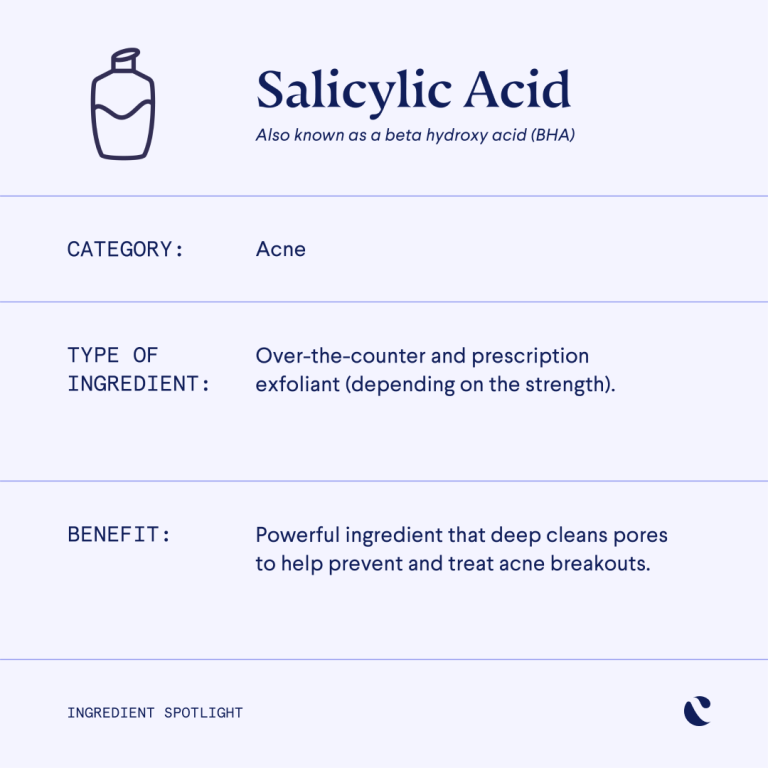How it works:
Share your skin goals and snap selfies
Your dermatology provider prescribes your formula
Apply nightly for happy, healthy skin
How it works:
How it works:
Share your skin goals and snap selfies
Your dermatology provider prescribes your formula
Apply nightly for happy, healthy skin
How it works:
Should you use salicylic acid?
Ask our dermatology providers!
How to use salicylic acid the right way, according to the experts
Can too much salicylic acid be a bad thing? Here’s what we know.



Welcome to Ask Curology, a column penned by one of our in-house medical providers in response to your questions about all things skincare. In this edition, we’re talking about everybody’s favorite beta hydroxy acid: salicylic acid. You might have heard this skincare ingredient is tough on acne—but is it too tough? Here one of our medical providers gives the scoop on salicylic acid safety.
Dear Curology,
When I was younger, I’d get the occasional pimple, but lately, I’ve been breaking out intensely all over my face, neck, and back. My mom told me salicylic acid is good for acne, so I looked for products with that ingredient. I’ve been using a face wash, body wash, and spot treatment with salicylic acid every day. At first, my skin started to clear up. But now, my face is as red as a tomato. It’s even getting dry and flaky in areas, and I definitely didn’t have that problem before. It’s like I took one step forward and two steps back. What should I do?
Signed, Sally Silly Acid
Dear Sally,
Your mom is right; salicylic acid can be great for acne. It’s a common over-the-counter ingredient used for the treatment of acne. It cleans deep down into pores and unclogs them to help prevent and treat breakouts.¹
But not all salicylic acid products are created equally. Some products that contain salicylic acid can be too intense for everyday use. And when it comes to salicylic acid, it is possible to have too much of a good thing. It sounds like the number of salicylic acid products you’re using daily is too much for your skin to handle. So, let’s get into how salicylic works—and how it can work well for your skin.
How does salicylic acid work?
Simply put, salicylic acid is a chemical exfoliant that helps prevent and treat blocked pores. Your skin naturally produces oil, called sebum, in the sebaceous glands. An overproduction of sebum is one factor that can lead to clogged or blocked pores, which can lead to acne, explains Dr. Whitney Tolpinrud, a board-certified dermatologist at Curology. Because salicylic acid is oil-soluble, it can penetrate through the sebum of a clogged pore to the lining of the pore. Salicylic acid can also buff away dead skin cells. In this way, salicylic acid helps to prevent and treat blocked pores. This makes it an excellent option for saying goodbye to whiteheads and blackheads (along with other types of acne).

How to use salicylic acid
Salicylic is generally considered a safe skincare ingredient that’s usually okay for people with all skin types to use, but we often recommend it for people with oily skin. No matter your skin type, it’s essential to go slowly when introducing a new product that contains salicylic acid. We suggest starting once or twice weekly and increasing the frequency as tolerated.
You can use either a cleanser with salicylic acid or a different salicylic acid product, but we don't typically recommend using both. Using more than one type of salicylic acid product at a time can be too harsh on your skin and cause irritation. If you opt for a toner or facial wipe with salicylic acid, prep your skin by washing your face with a gentle, non-drying, non-salicylic acid cleanser first. Remember to allow your skin to dry completely before applying any prescription acne medication (like your personalized Curology formula).
Salicylic acid can be helpful, but it’s easy to overdo exfoliation! Redness and irritation can occur with overuse.² If you experience any of these symptoms, your skin most likely needs a break. We recommend pausing the use of any exfoliating products (including salicylic acid) until your skin returns to normal, and then slowly reintroducing the salicylic acid product to your routine. If you feel your reaction is more significant, reach out to your Curology dermatology provider or an in-person medical provider to determine whether another issue could be at hand.
Wondering if you have skin allergies or just sensitive skin? Click here to learn more.
Salicylic acid product recommendations
At Curology, we’re all about helping you achieve your skin goals, and that starts with having a consistent and effective skincare routine. When we recommend products, it's because they contain skincare ingredients we think can lend a hand in getting you there. Here are some options our experts recommend:
Salicylic acid cleansers
Salicylic acid cleansers are a great way to help exfoliate and treat mild acne. Generally speaking, they’re a gentle option, as salicylic acid only comes into contact with the skin briefly before being rinsed off.
Dermalogica Clearing Skin Wash with 0.5% salicylic acid
Neutrogena Oil-Free Acne Wash with 2% salicylic acid
The Inkey List BHA Serum with 2% salicylic acid
Salicylic acid body washes
If you’ve ever experienced body breakouts, you probably know how stubborn they can be. Enter: salicylic acid body wash, which helps clear dead skin cells and dirt from pores to minimize acne on your shoulders, chest, neck, and back, and leave your skin feeling smoother.
The acne body wash by Curology with 2% salicylic acid
Neutrogena Body Clear Body Wash with 2% salicylic acid
Dermalogica Clearing Skin Wash with 0.5% salicylic acid
Salicylic acid exfoliating treatments
Exfoliating treatments are another popular way to incorporate salicylic acid into your everyday skincare routine. From wipes to liquids, you can try using these products after cleansing and before applying your moisturizer.
Stridex Strength Medicated Pads with 2% salicylic acid
Paula’s Choice 2% BHA Liquid with 2% salicylic acid
Paula’s Choice RESIST Advanced Pore Refining Treatment with 4% salicylic acid
If you’re wondering what concentration of salicylic acid is best for your skin, 2% salicylic acid is generally well-tolerated by most people. If you’re just starting out or have dry or sensitive skin, you might do better with a lower strength, like 0.5%. When in doubt, consult your dermatology provider if you have any questions or concerns.
Benefits of using salicylic acid
There are many reasons experts often recommend salicylic acid products to treat blemishes. Here are some of the ingredient’s top benefits:
Exfoliates. Salicylic acid is a chemical exfoliant that helps to gently remove excess dead skin cells that may contribute to clogged pores.³
Fights comedones. Salicylic acid is particularly effective at treating comedones (aka clogged pores like whiteheads and blackheads).
Reduces inflammation. Salicylic acid also has anti-inflammatory properties which are most pronounced at concentrations between 0.5% and 5%.⁴
Possible side effects of salicylic acid
Salicylic acid has potential side effects, including irritation such as burning or stinging.⁵ But as long as you’re not overdoing it, they shouldn’t be extreme. That said, it is possible to use too much—so keep an eye out to see how your skin reacts as you use products with salicylic acid.
Considerations before using salicylic acid
Salicylic acid is available in many over-the-counter products, making it an accessible go-to skincare ingredient for treating and helping to prevent breakouts. But before you start using salicylic acid, there are a few precautions to consider and factors that may increase the risk of side effects. If you’re unsure whether salicylic acid is right for you, you can always talk to an expert at Curology or your in-person dermatology provider. Out of caution, it’s important to consider the following:
Allergic reactions. Some skincare ingredients, including salicylic acid, may cause allergic reactions. If you’re concerned that you may have an allergic reaction or are prone to reactions from topical products, speak with your medical provider before beginning a salicylic acid treatment.
Irritation. Other topicals such as retinoids, products containing certain types of alcohol, or harsh skincare products may cause irritation when combined with salicylic acid.
Pregnancy. Is salicylic acid pregnancy-safe? While some acne medications are not recommended for use while you’re pregnant, lower concentrations of salicylic acid (no more than 2%) are generally considered safe to use during pregnancy—in small amounts for a limited duration.⁶ Still, getting your medical provider's approval (specifically, your OB/GYN) before beginning to use salicylic acid while pregnant is always recommended.
Kidney disease or liver disease. In rare cases (like, very rare!), a severe condition known as salicylate toxicity could occur.⁷
Ingredients to use with caution when using salicylic acid
Tretinoin: Tretinoin is a prescription retinoid that has been shown to effectively treat acne.⁸ It’s also one of our go-to favorites. But if combined with salicylic acid, it can lead to irritation. If you’re using tretinoin and want to try a salicylic acid product, start with low strength and go slow!
Benzoyl peroxide: Benzoyl peroxide is another powerful acne-fighting ingredient that is also good for the prevention of bacterial resistance with topical acne treatment,⁹ but if used along with salicylic acid, it may cause irritation.
An ingredient you can use with salicylic acid
Hyaluronic acid: Hyaluronic acid can be great for hydrating your skin. After using a product that contains a potentially drying ingredient like salicylic acid, a serum or moisturizer with hyaluronic acid can help keep your skin extra happy.

When to use salicylic acid
Many different skincare products contain salicylic acid, so the way you use this acne-fighting ingredient is up to you. The best way to use salicylic acid in your skincare routine will depend on what kind of product you’re using. Since many face washes contain salicylic acid, you can generally use these cleansers in the morning or evening. If you’re using salicylic acid as a toner or topical acne treatment, you can usually use it after washing your face. Be sure to check the instructions for the correct use of your specific product! As with any skincare routine, remember to moisturize with a non-comedogenic face lotion to help keep dryness and potential irritation away.
As always, if you have any questions, feel free to reach out to your Curology provider. If you’re not yet a member, you can sign up for a free month of Curology*. Members get paired with an in-house licensed dermatology provider for a skincare consultation and a personalized formula for their skin’s needs.
Get your personalized skincare routine with Curology
Get your personalized skincare routine with Curology


Curology brings dermatologist-designed skin care right to your door that’s customized for you so you can be sure the ingredients are targeting your specific skin concerns and goals.
FAQs
Simply put, salicylic acid is a chemical exfoliant that helps prevent and treat blocked pores. Your skin naturally produces oil, called sebum, in the sebaceous glands. An overproduction of sebum is one factor that can lead to clogged or blocked pores, which can lead to acne.
Salicylic is generally considered a safe skincare ingredient that’s usually okay for people with all skin types to use, but we often recommend it for people with oily skin. No matter your skin type, it’s important to go slowly when introducing a new product that contains salicylic acid. We suggest starting once or twice weekly and increasing the frequency as tolerated.
The best way to use salicylic acid in your skincare routine will depend on what kind of product you’re using. Since many face washes contain salicylic acid, you can generally use these cleansers in the morning or evening. If you’re using salicylic acid as a toner or topical acne treatment, you can use it after washing your face. Check the instructions for the correct use of your specific product! As with any skincare routine, remember to moisturize with a non-comedogenic face lotion to help keep dryness and potential irritation away.
P.S. We did the research so you don’t have to:
Zaenglein, A. L., et al.Guidelines of care for the management of acne vulgaris. Journal of the American Academy of Dermatology. (2016, February 17).
American Academy of Dermatology Association. How to safely exfoliate at home. (n.d.)
Decker, A., & Graber, E. M. Over-the-counter Acne Treatments: A Review. The Journal of clinical and aesthetic dermatology. ( May 2012).
Arif T. Salicylic acid as a peeling agent: a comprehensive review. Clinical, cosmetic and investigational dermatology. (2015).
Mayo Clinic Staff. Salicylic Acid (Topical Route): Side Effects. (2022, February 1).
Chien, A. L., et al. Treatment of Acne in Pregnancy. Journal of the American Board of Family Medicine. (2016).
Madan, R. K., & Levitt, J. A review of toxicity from topical salicylic acid preparations. Journal of the American Academy of Dermatology. (2014).
Leyden, J., et al. Why Topical Retinoids Are Mainstay of Therapy for Acne. Dermatology and therapy, (September, 2017).
Zaenglein, A. L., et al.Guidelines of care for the management of acne vulgaris. Ibid.
* Subject to consultation. Subscription is required. + $5.45 shipping and handling. Trial is 30 days. Results may vary.
Elise Griffin is a certified physician assistant at Curology. She received her Master of Medical Science in physician assistant studies from Nova Southeastern University in Jacksonville, FL.
This article was originally published on June 17, 2022, and updated on November 28, 2022.

Curology Team

Elise Griffin, PA-C
Related Articles
Is washing your face making your acne worse? Ask an expert25 skincare myths debunked: what you need to knowAsk a skin expert: Your skin’s damaged skin barrierWhat’s causing your skin irritation and how to stop itHow to treat dry, flaky skin and rosaceaPopular Articles
Ask Curology: Is my cold breaking me out?Slugging: The dermatologist-approved skincare hack going viral on TikTokTretinoin vs retinol: What’s the difference?How to create a self-care routine that actually sticksYour 2023 skincare horoscopeTry prescription skincare
Get routine essentials


Good skin days ahead
Good skin days ahead
- Breakouts
- Redness
- Fine lines
- Dark spots
- Hair thinning
$29.95/month